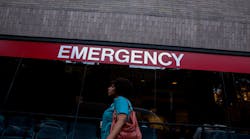When Thomas Eric Duncan got sick and his family dialed 911, fire/EMS were first on the scene and transported him to the hospital. If Ebola spreads, this scenario will be repeated over and over, says International Association of Fire Fighters General President Harold Schaitberger, and fire fighter/paramedics must be ready.
“Too many jurisdictions in the United States and Canada have not adequately provided the training, equipment and resources fire fighter/paramedics need to respond appropriately and safely to potential Ebola incidents,” said Schaitberger
The 2014 Ebola epidemic is the largest in history and has spread to multiple countries in West Africa. The first confirmed case in North America was reported in Dallas, Tex., where the 9-1-1 system was used to treat and transport patient Thomas Eric Duncan to the hospital. Duncan did not survive. Meanwhile, the ambulance crew – all members of Dallas Local 58 – have been taken off duty with pay and are under continuous medical observation at their homes.
It is likely that more individuals infected with Ebola will seek assistance from emergency response personnel as the disease spreads.
The IAFF is urging every affiliate to conduct a "safety stand down" with their employer and review all infectious exposure policies, procedures and guidelines. You should assess your department's preparedness for responding to and caring for patients with possible symptoms of the Ebola virus and whether you have the equipment and training needed for safely responding to worst-case scenarios in potential Ebola exposures should this virus spread in the United States and Canada.
All policies, procedures and guidelines should, at a minimum, address the following, according to IAFF:
- Use standard precautions, including fluid resistant and or impermeable long-sleeved gowns, single or double gloves, eye protections, leg coverings and disposable shoe covers. The IAFF recommends N95 respirators for all patients with respiratory symptoms.
- If there is a potential exposure, or the crew thinks they have been affected, they should not return to the firehouse. After transport, the unit should be removed from service while at the hospital. If an engine and EMS unit both respond, they should stay together throughout the call to keep other fire fighters from potential contamination. Exposure reporting should be activated from the hospital or while in route to the hospital with the patient.
- Establish follow-up and reporting measures after caring for a suspected or confirmed Ebola patient.
- Develop policies for monitoring and management of EMS personnel potentially exposed to Ebola. Policies should be flexible in terms of the amount of time required for monitoring and potential isolation of exposed personnel.
- Establish sick leave policies for personnel that are non-punitive, flexible and consistent with public health guidance.
- Ensure that all personnel, including staff who are not directly employed to provide patient care but provide essential daily services, also are aware of the sick leave policies.
- Ensure that fire and EMS personnel exposed to blood, bodily fluid, secretions or excretions from a patient with a suspected or confirmed Ebola virus immediately: 1) Stop working and wash the affected skin surfaces with soap and water and irrigate with a large amount of water or eyewash solution. 2) Contact an occupational health supervisor for assessment and access to post-exposure management services. 3) Receive medical evaluation and follow-up care as appropriate. Medical evaluations should include fever monitoring twice daily throughout the Ebola incubation period, which is two to 21 days.
- Establish return-to-work protocols according to EMS agency policy and discussions with local, state and federal public health authorities.
- Fire and EMS personnel who develop sudden onset of fever, intense weakness or muscle pains, vomiting, diarrhea, abdominal pains or any other symptoms after an unprotected exposure should not report to work or, if at work, immediately stop working, isolate themselves, notify their supervisor (who should notify local and state health departments as appropriate), contact an occupational health supervisor for assessment and post-exposure management service and comply with work exclusions until they are considered no longer infectious to others.
- Identify a single occupational health representative for reporting exposures.
- Fit test all personnel for use of N95 masks and provide them, as well as appropriate eye protection.
The transmission of the Ebola virus occurs through direct contact with blood and bodily fluids of an infected person. It can also be transmitted through exposure to objects that are contaminated by the bodily fluids, such as needles or other medical equipment. Healthcare workers, including fire fighters and EMS personnel, are at the highest risk of becoming sick because they are exposed daily to many patients with common symptoms of Ebola and other infectious diseases.
The Centers for Disease Control and Prevention (CDC) provides important guidance documents, most notably the Interim Guidance for Emergency Medical Services (EMS) Systems and 9-1-1 Public Safety Answering Points (PSAPs) for Management of Patients With Known or Suspected Ebola Virus Disease and EMS Checklist for Ebola Preparedness.

